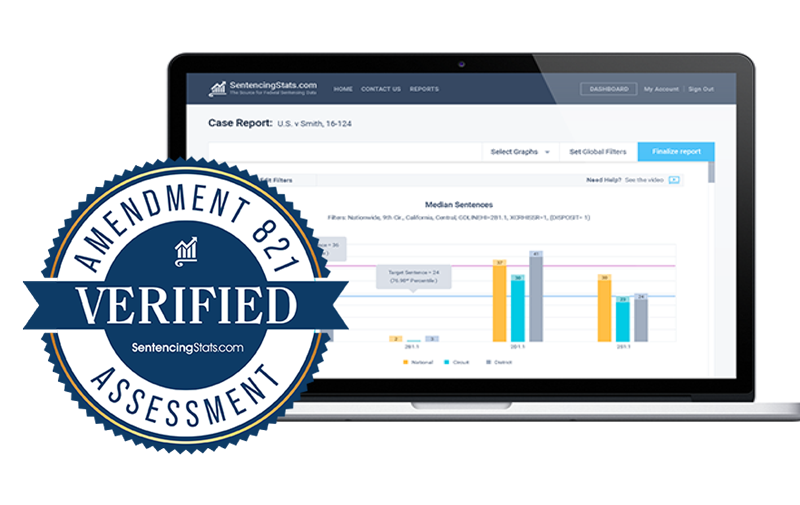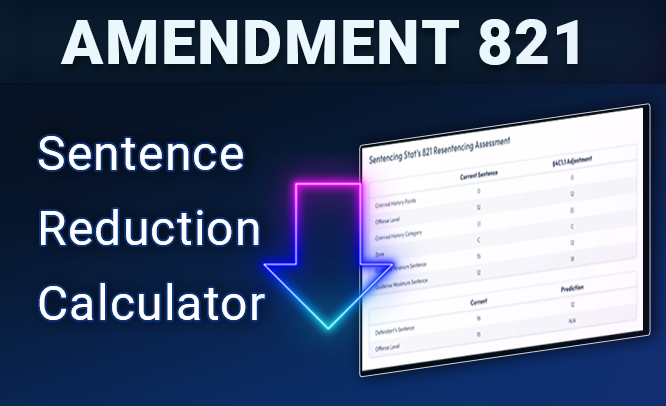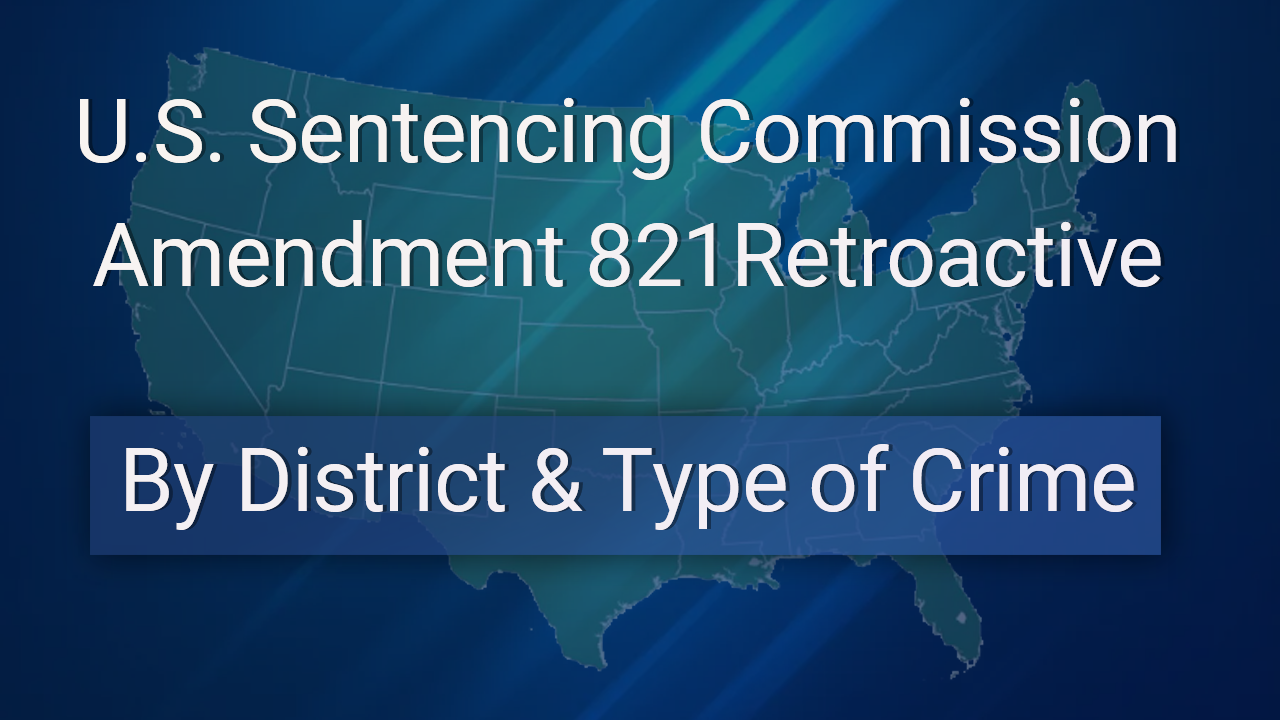U.S. Sentencing Commission report lists estimated number of defendants eligible for a retroactive reduction by district and type of offense.
The below tables display estimates of the number of inmates eligible for retroactive sentence reduction under Amendment 821 Part A (status points) and Part B (zero point offender) sub-amendments, by district. Also included are estimates of the number of eligible cases by type of crime for each of the sub-amendments. Florida, Texas and California in particular bear a large percentage of eligible inmates.
Table 2A
Geographic Distribution of Offenders Eligible Under Part A
By District
District | N | % | District | N | % | |
TOTAL | 11,495 | 100.0 | ||||
Western Texas | 822 | 7.2 | North Dakota | 91 | 0.8 | |
Southern Texas | 647 | 5.6 | Middle Pennsylvania | 90 | 0.8 | |
Northern Texas | 525 | 4.6 | Western New York | 89 | 0.8 | |
Eastern Tennessee | 345 | 3.0 | South Dakota | 89 | 0.8 | |
Eastern North Carolina | 336 | 2.9 | Southern Alabama | 88 | 0.8 | |
Eastern Virginia | 305 | 2.7 | Southern California | 87 | 0.8 | |
Northern Ohio | 265 | 2.3 | Northern Indiana | 87 | 0.8 | |
Western Missouri | 264 | 2.3 | Eastern Louisiana | 76 | 0.7 | |
Eastern Missouri | 263 | 2.3 | New Jersey | 75 | 0.7 | |
Eastern Texas | 228 | 2.0 | Western Oklahoma | 72 | 0.6 | |
Maryland | 207 | 1.8 | Idaho | 71 | 0.6 | |
Western North Carolina | 203 | 1.8 | Utah | 71 | 0.6 | |
Middle Florida | 196 | 1.7 | Northern West Virginia | 71 | 0.6 | |
Southern Georgia | 194 | 1.7 | Western Kentucky | 68 | 0.6 | |
Puerto Rico | 194 | 1.7 | Eastern Wisconsin | 68 | 0.6 | |
Southern Florida | 192 | 1.7 | Northern California | 63 | 0.6 | |
Arizona | 188 | 1.6 | Nebraska | 63 | 0.6 | |
South Carolina | 185 | 1.6 | Eastern New York | 59 | 0.5 | |
Eastern Kentucky | 178 | 1.6 | Western Arkansas | 58 | 0.5 | |
Southern Iowa | 157 | 1.4 | Southern West Virginia | 57 | 0.5 | |
Eastern Michigan | 157 | 1.4 | Eastern Oklahoma | 55 | 0.5 | |
Western Tennessee | 156 | 1.4 | Connecticut | 54 | 0.5 | |
Middle North Carolina | 153 | 1.3 | Middle Tennessee | 54 | 0.5 | |
Northern Alabama | 147 | 1.3 | Northern Oklahoma | 52 | 0.5 | |
Southern Indiana | 146 | 1.3 | Middle Alabama | 49 | 0.4 | |
New Mexico | 143 | 1.2 | Northern New York | 47 | 0.4 | |
Eastern Pennsylvania | 142 | 1.2 | Oregon | 46 | 0.4 | |
Northern Iowa | 140 | 1.2 | Eastern Washington | 45 | 0.4 | |
Southern New York | 140 | 1.2 | District of Columbia | 44 | 0.4 | |
Central California | 138 | 1.2 | Northern Mississippi | 44 | 0.4 | |
Northern Georgia | 134 | 1.2 | Hawaii | 42 | 0.4 | |
Eastern Arkansas | 131 | 1.1 | Nevada | 38 | 0.3 | |
Eastern California | 114 | 1.0 | Alaska | 37 | 0.3 | |
Kansas | 112 | 1.0 | Massachusetts | 34 | 0.3 | |
Western Virginia | 109 | 1.0 | Northern Florida | 32 | 0.3 | |
Southern Ohio | 108 | 0.9 | Wyoming | 32 | 0.3 | |
Northern Illinois | 105 | 0.9 | Western Washington | 29 | 0.3 | |
Central Illinois | 104 | 0.9 | New Hampshire | 28 | 0.2 | |
Western Michigan | 103 | 0.9 | Middle Louisiana | 22 | 0.2 | |
Middle Georgia | 100 | 0.9 | Western Wisconsin | 21 | 0.2 | |
Southern Illinois | 99 | 0.9 | Maine | 18 | 0.2 | |
Montana | 99 | 0.9 | Delaware | 12 | 0.1 | |
Southern Mississippi | 98 | 0.9 | Vermont | 7 | 0.1 | |
Western Louisiana | 97 | 0.8 | Guam | 5 | 0.0 | |
Western Pennsylvania | 97 | 0.8 | Rhode Island | 5 | 0.0 | |
Colorado | 91 | 0.8 | Virgin Islands | 2 | 0.0 | |
Minnesota | 91 | 0.8 | Northern Mariana Islands | 0 | 0.0 |
SOURCE: U.S. Sentencing Commission, FY 1991 through FY 2022 Datafiles, USSCFY91-USSCFY22, and Preliminary Data from FY 2023, USSCFY23.
Type of crime of offenders eligible for retroactive application of the amendment
Table 5 provides the type of crime for the instant offense of offenders eligible for a reduction in sentence pursuant to Part A of the 2023 criminal history amendment. Drug trafficking was the most common instant offense (40.5%) among offenders eligible to seek a modification of sentence under 18 U.S.C. § 3582(c)(2).
Table 5A
Instant Type of Crime for Offenders Eligible Under Part A
Crime Type
N
%
TOTAL
11,495
100.0
Drug Trafficking Firearms Robbery Immigration
Fraud/Theft/Embezzlement Child Pornography
Assault Sexual Abuse
Money Laundering Murder
Prison Offenses Obscenity/Other Sex Offenses Kidnapping Stalking/Harassing Administration of Justice
Manslaughter
4,658
2,371
1,391
1,049
419
325
257
250
171
156
144
55
43
39
35
35
40.5
20.6
12.1
9.1
3.7
2.8
2.2
2.2
1.5
1.4
1.3
0.5
0.4
0.3
0.3
0.3
All Other Crime Types
97
0.8
SOURCE: U.S. Sentencing Commission, FY 1991 through FY 2022 Datafiles, USSCFY91-USSCFY22, and Preliminary Data from FY 2023, USSCFY23.
Extent of possible sentence reduction
As discussed above, the average extent of reduction for offenders who are eligible for a reduced sentence under Part A of the 2023 criminal history amendment is 11.7 percent. Figure 1 shows the distribution of the extent of the possible reductions by the sentence length for these offenders. A majority (60.7%) of offenders would receive a sentence reduction of one year or less. Conversely, 2.3 percent would receive a sentence reduction of more than 36 months.
Table 2B
Geographic Distribution of Offenders Eligible Under Part B
By District
District
N
%
District
N
%
TOTAL
7,272
100.0
Middle Florida
1,122
15.4
Montana
31
0.4
Southern Texas
717
9.9
Northern California
30
0.4
Western Texas
695
9.6
Middle Georgia
30
0.4
Southern Florida
636
8.8
Eastern Louisiana
29
0.4
Northern Texas
426
5.9
Western New York
29
0.4
Eastern Texas
303
4.2
District of Columbia
28
0.4
Puerto Rico
195
2.7
Northern Oklahoma
28
0.4
Southern California
137
1.9
Nevada
27
0.4
Southern New York
115
1.6
New Mexico
27
0.4
Eastern Virginia
109
1.5
South Dakota
27
0.4
Northern Georgia
104
1.4
Eastern New York
26
0.4
New Jersey
92
1.3
Middle Pennsylvania
26
0.4
Central California
87
1.2
Western Virginia
26
0.4
Eastern Pennsylvania
75
1.0
Idaho
25
0.3
Eastern California
73
1.0
Southern Illinois
25
0.3
Eastern Tennessee
72
1.0
Northern Florida
24
0.3
Northern Ohio
65
0.9
Northern Iowa
24
0.3
Northern Alabama
63
0.9
Western Oklahoma
24
0.3
Nebraska
61
0.8
Virgin Islands
24
0.3
Eastern Michigan
60
0.8
Northern Indiana
23
0.3
Massachusetts
59
0.8
Eastern Washington
23
0.3
Eastern Kentucky
58
0.8
Connecticut
21
0.3
Colorado
55
0.8
New Hampshire
21
0.3
Eastern North Carolina
54
0.7
Northern West Virginia
21
0.3
Northern Illinois
53
0.7
Western Tennessee
19
0.3
Eastern Missouri
52
0.7
Central Illinois
18
0.3
Western Missouri
52
0.7
Oregon
18
0.3
Southern Indiana
51
0.7
Western Kentucky
17
0.2
Utah
51
0.7
Southern West Virginia
16
0.2
Southern Ohio
50
0.7
Western Washington
16
0.2
Kansas
48
0.7
Eastern Oklahoma
15
0.2
Maryland
47
0.7
Western Arkansas
13
0.2
Arizona
45
0.6
Guam
13
0.2
Western North Carolina
43
0.6
Middle Alabama
11
0.2
Northern New York
43
0.6
Middle Louisiana
11
0.2
Minnesota
42
0.6
Western Wisconsin
11
0.2
South Carolina
42
0.6
North Dakota
10
0.1
Southern Alabama
41
0.6
Wyoming
8
0.1
Southern Georgia
41
0.6
Alaska
7
0.1
Eastern Arkansas
40
0.6
Maine
7
0.1
Southern Mississippi
39
0.5
Northern Mississippi
7
0.1
Hawaii
35
0.5
Rhode Island
6
0.1
Western Pennsylvania
34
0.5
Delaware
5
0.1
Western Michigan
33
0.5
Vermont
5
0.1
Middle North Carolina
33
0.5
Eastern Wisconsin
4
0.1
Southern Iowa
31
0.4
Northern Mariana Islands
3
0.0
Western Louisiana
31
0.4
Middle Tennessee
3
0.0
SOURCE: U.S. Sentencing Commission, FY 1991 through FY 2022 Datafiles, USSCFY91-USSCFY22, and Preliminary Data from FY 2023, USSCFY23.
Type of crime of zero-point offenders eligible for retroactive application of the amendment
Table 5 provides the type of crime for the instant offense of offenders eligible for a reduction in sentence pursuant to Part B, Subpart 1 of the 2023 criminal history amendment. Drug trafficking was the most common instant offense (74.3%) for eligible zero-point offenders.
Table 5B Instant Type of Crime
for Offenders Eligible Under Part B
Crime Type
N
%
TOTAL
7,272
100.0
Drug Trafficking Fraud/Theft/Embezzlement Money Laundering Immigration Bribery/Corruption
Tax
Administration of Justice Obscenity/Other Sex Offenses Stalking/Harassing
Manslaughter
5,404
932
421
154
92
87
41
31
26
18
74.3
12.8
5.8
2.1
1.3
1.2
0.6
0.4
0.4
0.2
All Other Crime Types
66
0.9
SOURCE: U.S. Sentencing Commission, FY 1991 through FY 2022 Datafiles, USSCFY91-USSCFY22, and Preliminary Data from FY 2023, USSCFY23.
Extent of possible sentence reduction
As discussed above, the average extent of reduction for offenders who are eligible for a reduced sentence under Part B, Subpart 1 of the 2023 criminal history amendment is 17.6 percent. Figure 1 shows the distribution of the extent of the possible reductions by the sentence length for these offenders. More than half (51.9%) would receive a sentence reduction of one year or less. Conversely, 4.0 percent would receive a sentence reduction of more than 36 months.
Share and Download
We are sharing this chart to help people understand what districts and offense types will be impacted the most by 821. Feel free to send a link to this page, post on social or download a free pdf copy of this graphic to share with anyone who may benefit.
Need to get Verified?

We offer an Amendment 821 verified assessment for $49. If you choose to get verified, one of our legal professionals will help you gather all of the appropriate information and legal documents. Our team will then review the details of your case and determine: A. if the defendant will likely qualify, B. what the amended sentence range will likely be and C. offer a sentence prediction based on our proprietary data and analysis tools. Currently verifications take up to a week, although we do foresee a backlog so it’s advisable to seek verification sooner than later.
NOTE: This is not a replacement for legal representation and if you are unrepresented, it’s critical you seek legal representations. Verified sentencing data assessments are not legal advice.

Would you like to know how much a judge can reduce a qualified defendant’s sentence, under an Amendment 821 motion? Our Amendment 821 Resentencing Reduction Calculator will give you the answer in seconds.

